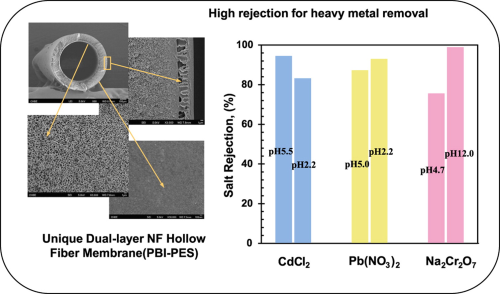
Researchers at the National University of Singapore have designed and characterised a high-performance dual-layer nanofiltration (NF) hollow fibre membrane for effective removal of heavy metal ions (Cd2+, Cr2O72− and Pb2+) from model wastewater.
The membrane was fabricated by the simultaneous co-extrusion of polybenzimidazole (PBI) and polyethersulfone (PES)/polyvinylpyrrolidone (PVP) dopes through a triple-orifice spinneret using a dry-jet wet phase inversion process.
PBI was chosen as the outer selective layer because of its superior chemical resistance and unique charge characteristics, while a PES/PVP blend was employed as the support layer because of its reasonable cost, superior spinnerablity, hydrophilic nature, good mechanical properties, and easy formation of porous membranes. In addition, PVP is miscible with both PBI and PES.
The newly developed dual-layer NF membrane has superior rejections to various salts. The rejections of the membrane to Mg2+ and Cd2+ achieve 98% and 95%, respectively. By changing the pH of the solution, the rejections to Cr2O72– and Pb2+ can reach more than 98% and 93%, respectively.
The experimental results indicate that the high rejections are owing to the following factors:
- A narrow pore size distribution membrane with a mean effective pore radius of 0.32 nm and a molecular weight cutoff (MWCO) of 249 Da.
- An enhanced Donnan exclusion effect due to the amphoteric PBI charge property; and
- Low adsorptions of heavy metals on the PBI surface due to its hydrophilic nature.
Journal of Membrane Science, Volume 456, 15 April 2014, Pages 117–127.



